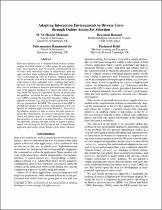 ResearchSpace
ResearchSpace
Adapting interaction environments to diverse users through online action set selection
JavaScript is disabled for your browser. Some features of this site may not work without it.
- ResearchSpace
- →
- Research Publications/Outputs
- →
- Conference Publications
- →
- View Item
| dc.contributor.author |
Hassan Mahmud, MM

|
|
| dc.contributor.author |
Rosman, Benjamin S

|
|
| dc.contributor.author |
Ramamoorthy, S

|
|
| dc.contributor.author |
Kohli, P

|
|
| dc.date.accessioned | 2014-08-25T10:25:01Z | |
| dc.date.available | 2014-08-25T10:25:01Z | |
| dc.date.issued | 2014-06 | |
| dc.identifier.citation | Hassan Mahmud, M.M, Rosman, B.S., Ramamoorthy, S and Kohli, P. 2014. Adapting interaction environments to diverse users through online action set selection. In: 3rd Workshop on Machine Learning for Interactive Systems (MLIS-2014), Quebéc City, Canada, 27-28 July 2014 | en_US |
| dc.identifier.uri | http://hdl.handle.net/10204/7633 | |
| dc.description | 3rd Workshop on Machine Learning for Interactive Systems (MLIS-2014), Quebéc City, Canada, 27-28 July 2014 | en_US |
| dc.description.abstract | Interactive interfaces are a common feature of many systems ranging from field robotics to video games. In most applications, these interfaces must be used by a heterogeneous set of users, with substantial variety in effectiveness with the same interface when configured differently. We address the issue of personalizing such an interface, adapting parameters to present the user with an environment that is optimal with respect to their individual traits - enabling that particular user to achieve their personal optimum. We introduce a new class of problem in interface personalization where the task of the adaptive interface is to choose the subset of actions of the full interface to present to the user. In formalizing this problem, we model the user as a Markov decision process (MDP), wherein the transition dynamics within a task depends on the type (e.g., skill or dexterity) of the user, where the type parametrizes the MDP. The action set of the MDP is divided into disjoint set of actions, with different action-sets optimal for different type (transition dynamics). The task of the adaptive interface is then to choose the right action-set. Given this formalization, we present experiments with simulated and human users in a video game domain to show that (a) action set selection is an interesting class of problems (b) adaptively choosing the right action set improves performance over sticking to a fixed action set and (c) immediately applicable approaches such as bandits can be improved upon. | en_US |
| dc.language.iso | en | en_US |
| dc.relation.ispartofseries | Workflow;13282 | |
| dc.subject | Interface adaptation | en_US |
| dc.subject | Action set selection | en_US |
| dc.subject | Online learning | en_US |
| dc.subject | Adapting parameters | en_US |
| dc.subject | Markov decision process | en_US |
| dc.title | Adapting interaction environments to diverse users through online action set selection | en_US |
| dc.type | Conference Presentation | en_US |
| dc.identifier.apacitation | Hassan Mahmud, M., Rosman, B. S., Ramamoorthy, S., & Kohli, P. (2014). Adapting interaction environments to diverse users through online action set selection. http://hdl.handle.net/10204/7633 | en_ZA |
| dc.identifier.chicagocitation | Hassan Mahmud, MM, Benjamin S Rosman, S Ramamoorthy, and P Kohli. "Adapting interaction environments to diverse users through online action set selection." (2014): http://hdl.handle.net/10204/7633 | en_ZA |
| dc.identifier.vancouvercitation | Hassan Mahmud M, Rosman BS, Ramamoorthy S, Kohli P, Adapting interaction environments to diverse users through online action set selection; 2014. http://hdl.handle.net/10204/7633 . | en_ZA |
| dc.identifier.ris | TY - Conference Presentation AU - Hassan Mahmud, MM AU - Rosman, Benjamin S AU - Ramamoorthy, S AU - Kohli, P AB - Interactive interfaces are a common feature of many systems ranging from field robotics to video games. In most applications, these interfaces must be used by a heterogeneous set of users, with substantial variety in effectiveness with the same interface when configured differently. We address the issue of personalizing such an interface, adapting parameters to present the user with an environment that is optimal with respect to their individual traits - enabling that particular user to achieve their personal optimum. We introduce a new class of problem in interface personalization where the task of the adaptive interface is to choose the subset of actions of the full interface to present to the user. In formalizing this problem, we model the user as a Markov decision process (MDP), wherein the transition dynamics within a task depends on the type (e.g., skill or dexterity) of the user, where the type parametrizes the MDP. The action set of the MDP is divided into disjoint set of actions, with different action-sets optimal for different type (transition dynamics). The task of the adaptive interface is then to choose the right action-set. Given this formalization, we present experiments with simulated and human users in a video game domain to show that (a) action set selection is an interesting class of problems (b) adaptively choosing the right action set improves performance over sticking to a fixed action set and (c) immediately applicable approaches such as bandits can be improved upon. DA - 2014-06 DB - ResearchSpace DP - CSIR KW - Interface adaptation KW - Action set selection KW - Online learning KW - Adapting parameters KW - Markov decision process LK - https://researchspace.csir.co.za PY - 2014 T1 - Adapting interaction environments to diverse users through online action set selection TI - Adapting interaction environments to diverse users through online action set selection UR - http://hdl.handle.net/10204/7633 ER - | en_ZA |





